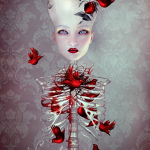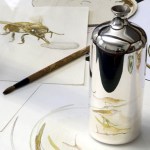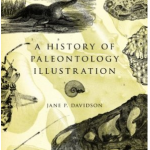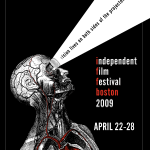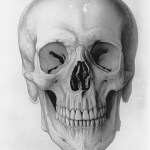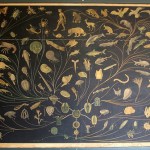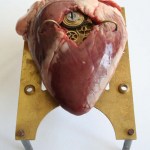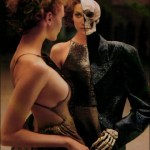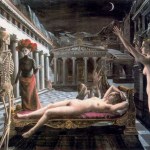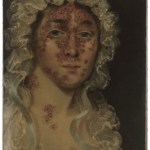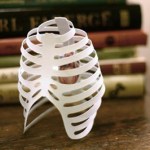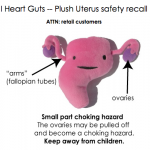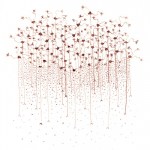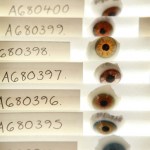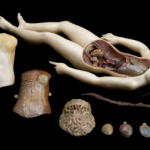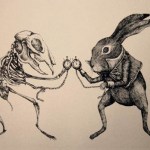Medical Illustration and History
The Lady of Broken Hearts
Natalie Shau
Lithuanian artist Natalie Shau works in digital media, mostly using Photoshop. You can see more of Shau's work at her website and at the website of jewelery designer Lydia Courteille, for whom she illustrated a cabinet-of-curiosities themed ad campaign. hat-tip: Haute Macabre.
The Ambassadors, 1533
Hans Holbein the Younger
In the artistic technique called anamorphosis, an object is depicted in distorted perspective, so that the viewer has to take special action, like looking from a specific angle, to see the "correct" image.
The most famous example of anamorphic painting is Hans Holbein's The Ambassadors (1533), a double portrait in which the illusion of highly detailed reality is fractured by a blurred grey streak superimposed across the painting's bottom third. If one stands at an acute angle, close to the painting, the blurred streak resolves itself into a…
Check out Brian's new review of A History of Paleontology Illustration (Life of the Past) by Jane Davidson, in Palaeontologia Electronica:
It is rare for fossils to be featured in fine art, but in the 15th century painting A Goldsmith in His Shop, Possibly Saint Eligius by the Flemish master Petrus Christus there is, if you look carefully, a fossil shark tooth among the objects scattered on the shop's table. The fossil plays a nearly insignificant role in the painting, but it reflects the general interpretation of such natural curiosities at the time. From this modest starting point,…
Christmas greeting card, school unknown, circa 1920.
Dittrick Medical History Center
from Dissection: Photographs of a Rite of Passage in American Medicine 1880-1930
Slate has an intriguing new review by Barron Lerner of a book called Dissection: Photographs of a Rite of Passage in American Medicine 1880-1930, by John Harley Warner and James M. Edmonson. The book delves into the turn-of-the-century practice of photographing medical students with cadavers - photos that today read as weird, grotesque, even offensive.
The photos unearthed by Warner and Edmonson depict an astonishing variety of…
The Independent Film Festival Boston kicked off today, and this was their ad campaign. Nice use of anatomical imagery!
This detailed medical illustration by the late Duncan Winter shows the advantages of a good medical illustration over a typical photograph. There are no problems with over- or under-exposure, no depth-of-field issues, and the salient features are subtly emphasized. The underside in particular is very impressive work - there's a lot going on down there and it's really tough to draw clearly.
From the medical illustration flickrset by Bottled Monsters
This beautiful painting is located in Martin Hall at Swarthmore College. Discovered via Colin Purrington's flickr feed.
New anatomical DIY project: get a CT scan, remix it to music, and post it on the web! That's what Jaymis did:
Inside The Jaymis: Skeleton Animation - Wide Time from Jaymis on Vimeo.
I got an MRI recently, but they didn't give me the results on a CD, so I can't do this. Now I feel all left out. Nevertheless, it's kind of odd looking at someone else's innards on a Sunday morning over tea. . . is this DIY TMI?
Via Andrew Sullivan.
Fixed Heart
offal with mixed metal components
Lisa Black, 2008
I blogged about New Zealand artist Lisa Black before, but I can't get over this great piece of hers. What does it signify? Does it represent the gradual replacement of the natural world around us with technology, to the point where our own bodies become artificial? Is it critiquing the reductionist tendencies of neurobiologists who believe our deepest emotions are complex but purely chemical reactions? Is it a steampunk Valentine? I don't know, and I don't really care - it's just cool.
Check out more from Black here.
Richard Avedon, The New Yorker, 1995
Via Haute Macabre, an unbelievable fashion editorial created by Richard Avedon for the New Yorker. I have no words.
Richard Avedon, The New Yorker, 1995
See the complete editorial at Haute Macabre.
The Sleeping Venus (1944)
Paul Delvaux
Observatory is a new collaborative art space located in Brooklyn, where it is reportedly sandwiched between Proteus Gowanus, Cabinet Magazine, and the Morbid Anatomy library. Its illustrious proprietors include Pam of Phantasmaphile, Joanna of Morbid Anatomy, and D&M of Curious Expeditions. And if that's not reason enough to be excited, tonight they are hosting a talk by Kathryn Hoffmann of the University of Hawaii at Manoa, entitled "Reveries of Sleeping Beauty: Slumber and Death in Anatomical Museums, Fairground Shows, and Art."
I saw Dr. Hoffmann…
Mrs. Bennett
circa 1818-1821
Wellcome Library
While browsing Morbid Anatomy recently I did a double take: is that the hypochondriac matriarch of Pride and Prejudice, only zombified? No, Lizzy's mother has not succumbed to the unmentionable scourge - yet. This Mrs. Bennett is a coincidentally named Georgian lady who suffered from an unnamed skin ailment, from which she fortunately makes a full recovery. You'll have to wait until my April 1 review of P&P&Z to discover if the Bennets of Longbourne are so lucky!
Via Morbid Anatomy: the Discovery Channel series "How It's Made" features the construction of modern anatomical models. You can watch the five-minute segment after the fold.
Discovery Channel, "How It's Made", Season 11, Episode 2/Part 1
This revealing anatomical card by Oregon designer Nathan Chrislip can be had for only $9 plus shipping on etsy. (Chrislip calls it a "valentine," but unless your beloved is also an avowed anatomophile, be sure to enclose a message making your nonviolent romantic intent clear.)
Via Rag and Bone Blog
I don't know how in hell I missed this one, but thank heavens A Repository for Bottled Monsters alerted me to the "Uterine Plush Recall" over at I Heart Guts! Apparently the uterus "failed a pull test" and "the ovaries may be pulled off and become a choking hazard"! I do not think I am alone in saying eeeuuuuww!
I Heart Guts assures us that rest of their smiling fuzzy internal organs are perfectly safe for all ages, but if you are in possession of a smug, Thriller video-dancing, pink plush uterus with hazardous trachea-sized violet ovaries, please contact appropriate support personnel…
Thought Patterns #1
blood on watercolor paper
Laura Splan, 2003
The International Museum of Surgical Science in Chicago is calling for proposals for "Anatomy in the Gallery:"
[This program] showcases medically themed contemporary art within the unique context of the Museum's historical collections and exhibits. The program was begun in 1998 to help fulfill the Museum's mission of enriching its visitors' lives by enhancing their knowledge and understanding of surgery and related sciences.
Previous exhibitors include Laura Splan (above), Laura Kurtenbach, Geraldine Ondrizek, and Dominic Paul…
A drawer of antique glass eye fragments
Photograph: Peter Macdiarmid/Getty Images
via The Guardian
A new slideshow from The Guardian highlights some of the wonderful medical artifacts found at the new "Brought to Life" website.
If you're in New York tonight, head over to the mysterious new "Observatory" between Proteus Gowanus, Cabinet Magazine, and the Morbid Anatomy Library for
(1) a book release party for Confronting Mortality with Art and Science: Scientific and Artistic Impressions on what the Certainty of Death Says About Life;
(2) a film screening of Art:Science = Science x Art;
and (3) conversation with some really, really cool people. I'm jealous that i'm down here in DC - even if I do get to go see Adam Gopnik tonight at Politics and Prose. I'm going to have to pre-order this darn book on Amazon like…
Wax anatomical figure of reclining woman, Florence, Italy, 1771-1800
Science Museum London
Starting today, the Wellcome Trust and sciencemuseum.org.uk open a brand spanking new collection of medical history archives. "Brought to Life: Exploring the History of Medicine" is searchable by people, place, thing, theme, and time. You can view a timeline of medical history in Europe next to similar timelines for the Islamic empire, Egypt and Greece (I do wish China and India were as prominently placed). You can read essays about larger questions, like what "wellness" means, or play with a cool…
Lepidus timidus
Erica il Cane, 2007
Erica il Cane (AKA ericailcane AKA "Eric the dog") would be the perfect illustrator for that macabre children's book about vivisection that Edward Gorey should have written. In his etchings and drawings, adorable anthropomorphic creatures interact with labeled skeletons or watch as their own organs are neatly exposed. Disturbing, creepy, amusing, with a dash of pathos. Some of the drawings appear inspired by the European tradition of medical moulage - except instead of langorous, lovely women, these anatomical specimens resemble Teddy Ruxpin and his ilk…
